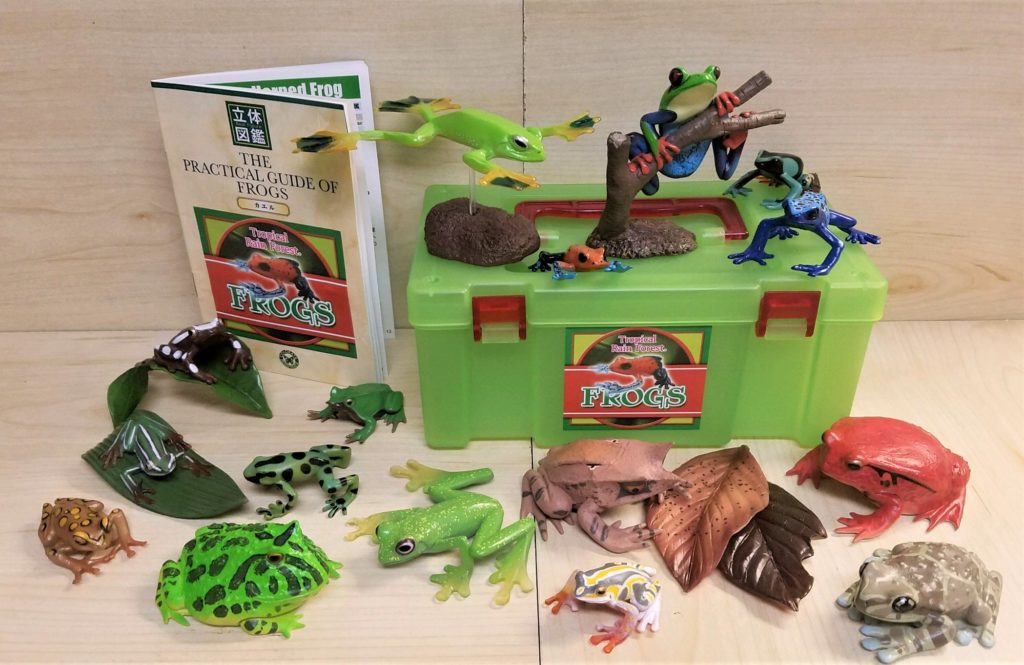This is the second part of a two-part review of the Tropical Rain Forest Frogs collection box by Colorata. Part 1 covered the Neotropical species. This second part covers the African, Madagascan, and Asian species.
Each figure is a single, solid piece of plastic. Five of the figures in the set come with a habitat-style base, three of which appear to be permanently attached to the base. The bottoms of the figures are variably marked. Some have the common name, some a year, some both. Those stamped with a year are stamped ‘2005’ but the accompanying booklet is marked 2019, which leads me to believe my set is a recent re-release. Some of you with older sets may have a different species composition than mine! I would be interested to hear if so. The Animal Toy Wiki site lists the same species, as does a 2014 post of the set on the ATF by stemturtle (maybe only the booklet was updated in 2019).
For each figure, I will give the common and Latin names, figure size (snout to vent length, keeping in mind they are all in the 1:1 range), plus other interesting information, including the acknowledgement of other figures of a given species in toy/figure form, assuming of course there are any others.

No. 9. Argus reed frog, Hyperolius argus
Figure length: 3.7 cm
Notes: There are a few species of Hyperolius in toy forum (not bad considering there are about 145 species in nature), including two in this collection. This Colorata Argus reed frog is unique. The species is endemic to coastal southeast Africa and lived in humid savanna and grasslands near water. The species is sexually dimorphic, and the golden-brown color with large cream spots seen in this figure indicates it is a female (although there is geographic and developmental variation).

No. 10. Rutenberg’s reed frog, Heterixalus rutenbergi
Figure length: 3.2 cm (total length of display with leaf, 9.0 cm)
Notes: This unique figure is another in the set that is permanently attached to its habitat-style base (or at the very least very snugly attached). This species is endemic to Madagascar.

No. 11. Marbled (painted) reed frog, Hyperolius marmoratus
Figure length: 3.3 cm
Notes: This is the other species of Hyperolius in the set and another unique species. The species is endemic to coastal countries in southeastern Africa. The figure is slightly translucent on the underside.

No. 12. Madagascan (painted) mantella, Mantella madagascariensis
Figure length: 3.0 cm
Notes: This colorful little figure is another unique species. In nature, the species is highly variable, and Colorata chose to paint this figure as one of the more striking varieties. There has been discussion on the ATF that this figure might actually represent M. baroni, however the features separating them are so slight, I think I will stick with Colorata’s identification. As the species epithet suggests, this species, like all mantellas, is endemic to Madagascar. In many ways, mantellas fill the same niche in Madagascar as the poison dart frogs do in Latin America. They are small, aposematically colored, and poisonous.

No. 13. Ankafana bright-eyed frog, Boophis luteus
Figure length: 5.0 cm
Notes: This species is in the same family (Mantellidae) as the preceeding species, and is also unique in toy/figure form. If the genus Mantella exhibits convergent evolution with the poison dart frogs, then the bright-eyed frogs in the genus Boophis exhibit a similar phenomenon with true tree frogs (Hylidae) and shrub frogs (Rhacophoridae). Like other mantellids, this species is endemic to Madagascar.

No. 14. False tomato frog, Dyscophus guineti
Figure length: 6.2 cm
Notes: This is another figure I was really excited to get! As the common name suggests, these frogs look like tomatoes! There are three species of tomato frog in the genus Dyscophus, all endemic to Madagascar. In addition to this figure, K&M International made two figures, one each for their Madagascar Polybag and Madagascar Nature Tube collections. To my knowledge, K&M did not market them at the species level, so they could easily represent this species or D. antongilii.

No. 15. Green flying frog, Rhacophorus reinwardtii
Figure length: 5.0 cm (total surface area taken up by legspan, 10.5 cm long by 9.0 cm wide)
Notes: Along with Darwin’s frog and the false tomato frog, this was the other top three figures in the set I was most excited for. Safari made a couple nice flying frogs for their Incredible Creatures line, but like most IC figures, they are too big for me. Like many Colorata figures generally, this figure comes with a base to which it attaches with a clear acrylic rod. The rod can be cut to the desired length of the collector and the figure can easy be displayed without the base or rod. This species is found in Southeast Asia and the Malaysian Archipelago.

No. 16. Malayan horned frog, Megophrys nasuta
Figure length: 6.5 cm (leaf base 8.5 cm long)
Notes: Last but not least, and I mean that, as this is one of the largest, bulkiest figures in the set (along with the false tomato frog). The figure comes with a couple dead leaves on which to rest, but interestingly there is not method of attachment to the base; the figure can loosely rest anywhere upon the leaves. This is one of two species I already had in my collection, the other being by Yujin. I am going to retain the Yujin figure because of its smaller size. As the common name suggests, this species is endemic to the Malaysian peninsula. Its shape and color allows for perfect camouflage among the leaf litter in which it lives.

Disclaimer: links to Ebay and Amazon on the AnimalToyBlog are affiliate links, so we make a small commission if you use them. Thanks for supporting us!



